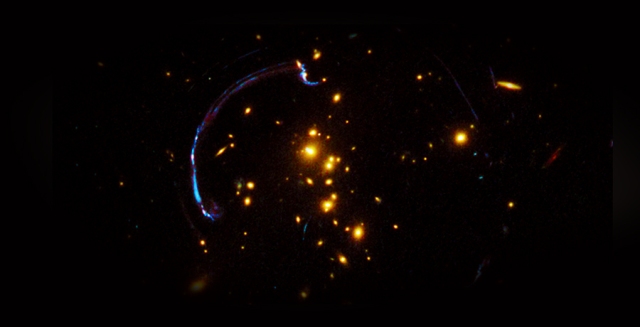Dec 24 2013
Smooth" or grainy? Is space-time continuous or is it made up of very fine (10-35 metres on the "Planck scale") but discrete grains, if we look at it very close up ? If the latter were true, scientists think, this would lead to deviations from the theory of special relativity formulated by Albert Einstein more than 100 years ago.
 Gravitational lens. Credits: NASA; ESA; J. Rigby (NASA Goddard Space Flight Center); and K. Sharon (Kavli Institute for Cosmological Physics, University of Chicago)
Gravitational lens. Credits: NASA; ESA; J. Rigby (NASA Goddard Space Flight Center); and K. Sharon (Kavli Institute for Cosmological Physics, University of Chicago)
In some theoretical scenarios, the "non-continuity" of space-time implies violations to the invariance of the physical laws under the so-called Lorentz transformations (which establish that physical laws are the same for all inertial reference frames that are at the basis of special relativity). Since the 90s physicists have devised several methods (often based on phenomena connected to high-energy astrophysics) to test these deviations from standard physics. Stefano Liberati, coordinator of the Astroparticle Physics group of the International School for Advanced Studies (SISSA) of Trieste, recently published a systematic review to present the state of the art in this field and the constraints that can be placed on the various models that predict violations to Special Relativity.
The paper is an invited Topic Review published in the journal Classical and Quantum Gravity. This journal periodically asks leading world experts to "sum up" what is known in a specific field of study. The review has now been selected as one of the journal's Highlight papers for 2013.
"Physicists have been wondering about the nature of space-time for years. We've been asking ourselves whether it is continuous at all scales, as we perceive it in our daily experience, or whether at very small sizes it presents an irregular grain that we, in our direct experience, are unable to perceive", explains Liberati. "Imagine looking at a slab of marble from some distance: it will probably seem to have a uniform texture. However, on closer inspection, for example using a powerful microscope, you can see that the marble is porous and irregular".
"In a certain sense physicists have been trying to do something similar with space-time: to find something that acts as a microscope to find out whether at very small length scales there is indeed some irregularity. In my paper I presented a systematic overview of the experiments and observations that can be exploited to investigate the existence of these irregularities. Special relativity is one of the cornerstones of modern physics and as such it is very important to test its validity, insofar as current observations allow us".